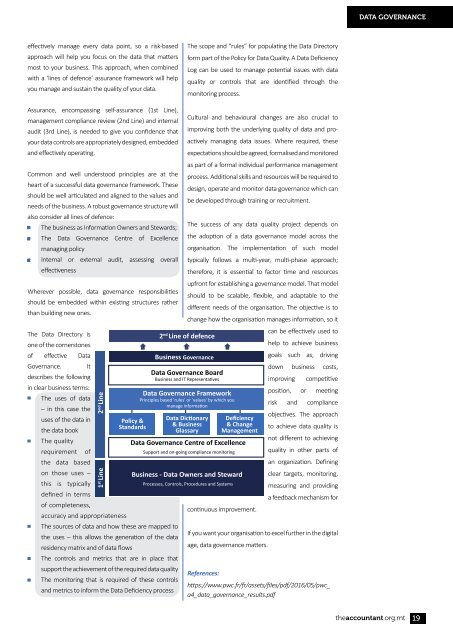ACCOUNTANT_SUMMER18_AMENDED_PG12
Create successful ePaper yourself
Turn your PDF publications into a flip-book with our unique Google optimized e-Paper software.
DATA GOVERNANCE<br />
effectively manage every data point, so a risk-based<br />
approach will help you focus on the data that matters<br />
most to your business. This approach, when combined<br />
with a ‘lines of defence’ assurance framework will help<br />
you manage and sustain the quality of your data.<br />
The scope and “rules” for populating the Data Directory<br />
form part of the Policy for Data Quality. A Data Deficiency<br />
Log can be used to manage potential issues with data<br />
quality or controls that are identified through the<br />
monitoring process.<br />
Assurance, encompassing self-assurance (1st Line),<br />
management compliance review (2nd Line) and internal<br />
audit (3rd Line), is needed to give you confidence that<br />
your data controls are appropriately designed, embedded<br />
and effectively operating.<br />
Common and well understood principles are at the<br />
heart of a successful data governance framework. These<br />
should be well articulated and aligned to the values and<br />
needs of the business. A robust governance structure will<br />
also consider all lines of defence:<br />
• The business as Information Owners and Stewards;<br />
• The Data Governance Centre of Excellence<br />
managing policy<br />
• Internal or external audit, assessing overall<br />
effectiveness<br />
Wherever possible, data governance responsibilities<br />
should be embedded within existing structures rather<br />
than building new ones.<br />
Cultural and behavioural changes are also crucial to<br />
improving both the underlying quality of data and proactively<br />
managing data issues. Where required, these<br />
expectations should be agreed, formalised and monitored<br />
as part of a formal individual performance management<br />
process. Additional skills and resources will be required to<br />
design, operate and monitor data governance which can<br />
be developed through training or recruitment.<br />
The success of any data quality project depends on<br />
the adoption of a data governance model across the<br />
organisation. The implementation of such model<br />
typically follows a multi-year, multi-phase approach;<br />
therefore, it is essential to factor time and resources<br />
upfront for establishing a governance model. That model<br />
should to be scalable, flexible, and adaptable to the<br />
different needs of the organisation. The objective is to<br />
change how the organisation manages information, so it<br />
The Data Directory is<br />
one of the cornerstones<br />
2 nd Line of defence<br />
can be effectively used to<br />
help to achieve business<br />
of effective Data<br />
Business Governance<br />
goals such as, driving<br />
Governance. It<br />
down business costs,<br />
Data Governance Board<br />
describes the following<br />
Business and IT Representatives<br />
improving competitive<br />
in clear business terms:<br />
Data Governance Framework<br />
position, or meeting<br />
• The uses of data<br />
Principles based 'rules' or 'values' by which you<br />
risk and compliance<br />
manage information<br />
– in this case the<br />
objectives. The approach<br />
uses of the data in<br />
Policy &<br />
Data Dictionary Deficiency<br />
Standards<br />
& Business & Change to achieve data quality is<br />
the data book<br />
Glassary Management<br />
• The quality<br />
Data Governance Centre of Excellence<br />
not different to achieving<br />
requirement of<br />
Support and on-going compliance monitoring<br />
quality in other parts of<br />
the data based<br />
on those uses –<br />
this is typically<br />
defined in terms<br />
of completeness,<br />
accuracy and appropriateness<br />
Business - Data Owners and Steward<br />
Processes, Controls, Procedures and Systems<br />
continuous improvement.<br />
an organization. Defining<br />
clear targets, monitoring,<br />
measuring and providing<br />
a feedback mechanism for<br />
• The sources of data and how these are mapped to<br />
the uses – this allows the generation of the data<br />
residency matrix and of data flows<br />
If you want your organisation to excel further in the digital<br />
age, data governance matters.<br />
• The controls and metrics that are in place that<br />
•<br />
support the achievement of the required data quality<br />
References:<br />
The monitoring that is required of these controls<br />
https://www.pwc.fr/fr/assets/files/pdf/2016/05/pwc_<br />
and metrics to inform the Data Deficiency process<br />
a4_data_governance_results.pdf<br />
1 st Line 2 nd Line<br />
theaccountant.org.mt<br />
19

















